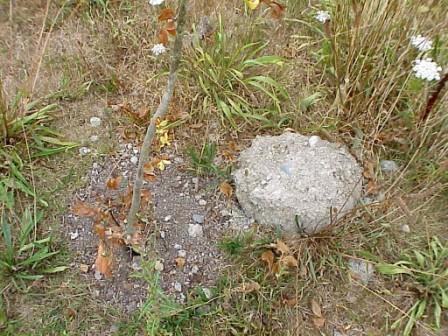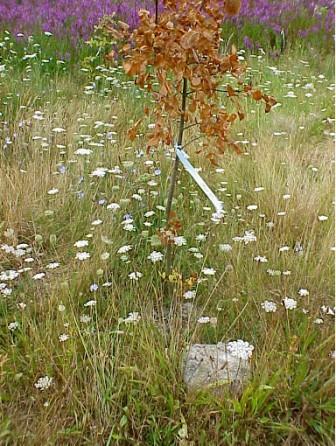Restoration ecology – the science of restoring degraded ecosystems – is another branch of applied plant sciences. Oddly enough, very little plant science makes it into the scientific literature of this field. This has driven me nuts for a number of years after reading an endless stream of papers where no mention is made of how plants are selected, installed, and managed. Or worse, some ancient horticultural practices are used – like amending the backfill with organic material rather than using just the native soil. Here’s what that will lead to:

Native soil discarded in favor of “lite-n-fluffy” amendment
 The whole story
The whole story
Restoration failures like this are often attributed to more esoteric causes, like lack of local plant gene pools in the plants used. Believe me, even local populations aren’t going to survive poor installation techniques.
Thus, one of my recent graduate students conducted a meta-analysis of the applied restoration ecology literature to analyze it for horticultural content. The results were not encouraging. In Kathleen’s thesis abstract, she states: “…careful selection and handling of planting stock, site and soil preparation, and rootball preparation, essential to increase survivorship of planted seedlings, are infrequently discussed in peer-reviewed restoration publications…Findings from this review support that restorationists either do not understand or are not providing important information to their peers, stakeholders, or the public on significant horticultural aspects of the restoration process.”
Now I know most of you are not restoration ecologists…but I’ll bet many of you are interested or actively involved in planting or maintaining native plant habitats, public greenspaces, degraded urban lots, etc. The science behind gardening is just as applicable to these “wilder” areas as it is to home landscapes and gardens.

Failure of entire installation. Note suckering from the roots – an attempt by the tree to establish a shorter crown. (It’s easier to transport water to a short crown than a tall one, and suckers are often a symptom of root failure)
I wonder how many gardeners are interested in native habitats. To me it seems connected and am involved in both. But when I talk to the garden club people about the volunteer effort to rescue the local forested park from invasive english ivy, there is little interest. Heck, there is little interest from the park management as well. I have not been able to find much research on the topic so have been using gardening knowledge to guess the best methods to use in a wild environment. Its great to see you addressing the topic.
Here in PA, the restoration activities seem to be managed from the Conservation and Forestry entities, usually working with volunteer watershed and stream health initiatives. We have a few Master Gardeners in our group who are active in those areas and who bring that perspective to us, but it’s true that the traditional Hort and Landscape folks and the Conservation and Forestry folks don’t have the same vocabulary, and, echoing VG, some
cross pollination of the disciplines is worth encouraging and pursuing.
Linda.
I am in arid Colorado and the problem with many restoration projects is the lack of supplemental water–at least during establishment. The trees you show in the photos were probably used to having daily waterings from the nursery and developed roots accordingly. As the water was suddenly cut back, the trees likely suffered from thirst and died. I noticed the other groundcover is doing well since it was likely established from seed in the native soil. We require temporary irrigation to get things established quickly and to keep the weeds from getting a head start. Slowly over a 2-year period irrigation is cut back to allow only natural precip.
We also require some plant-based amendment which I feel is innocuous, and more than anything else it lets me know that the contractor actually ripped the soil somewhat since our soils are heavy clay and highly compacted.
I love your idea of more science based restoration principles. My solutions have been from years of trial and error.
One question–if these photos are from a native restoration site, why are the trees planted in a linear pattern?
Thanks again for the great work and informative site.
use some gator bags!
Understanding native plant horticulture and ecology and even evolution is vital for restoration projects. I have seen projects that have failed from both ends.
Plant selection and density is key. A lot of restoration projects ignore native annuals which can really prevent weed infestations. Planting timing and watering is really important in my arid climate as well. I have seen more than enough midsummer plantings fail.
Then there is the question of propagation, instead of getting cloned nursery stock, you need to make sure to get plants with some genetic variation, preferably from a nearby area.
It’s stupidly easy to improve soil once you realize your job is to make the plants and microbes do the work. Plant (native, since this is ecological restoration) vigorous things with fairly substantial root systems that are suited to the site as it is. Mulch them with wood chips and baby them with some water the first year. By the next year, the soil will be enormously better. Add more mulch and plant slightly more delicate things. Repeat.